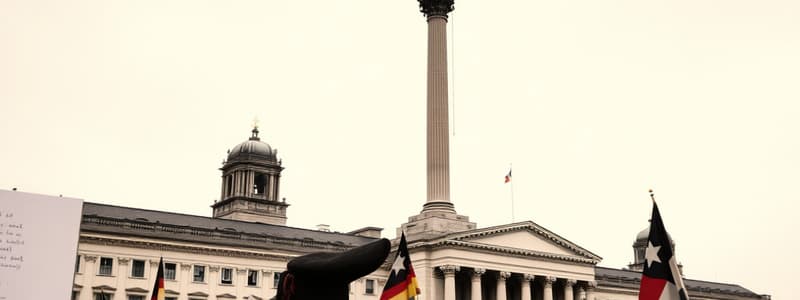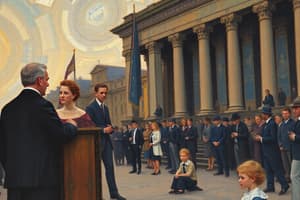Podcast
Questions and Answers
What was the main aim of the Weimar Republic?
What was the main aim of the Weimar Republic?
- Create a democratic government (correct)
- Establish a monarchy
- Promote military expansion
- Reinstate Kaiser Wilhelm II
The Reichstag was not elected by proportional representation.
The Reichstag was not elected by proportional representation.
False (B)
What economic crisis began in 1929 that significantly affected the Weimar Republic?
What economic crisis began in 1929 that significantly affected the Weimar Republic?
Great Depression
The attempted coup by right-wing factions in 1920 is known as the _____ Putsch.
The attempted coup by right-wing factions in 1920 is known as the _____ Putsch.
Which of the following events was a failed coup led by Adolf Hitler in 1923?
Which of the following events was a failed coup led by Adolf Hitler in 1923?
Match the following key figures or movements with their description:
Match the following key figures or movements with their description:
The Treaty of Versailles was widely accepted and celebrated by the German population.
The Treaty of Versailles was widely accepted and celebrated by the German population.
Who was the influential Chancellor during the stabilization period known as the Stresemann Era?
Who was the influential Chancellor during the stabilization period known as the Stresemann Era?
Flashcards are hidden until you start studying
Study Notes
Overview of the Weimar Republic
- Established in Germany after WWI (1919) following the abdication of Kaiser Wilhelm II.
- Named after the city of Weimar, where the constitution was drafted.
- Aimed to create a democratic government but faced significant challenges.
Political Structure
- Constitution: Democratic framework with a strong emphasis on civil liberties.
- Reichstag: The parliament, elected by proportional representation, often leading to unstable coalitions.
- President: Elected for seven years; held significant powers, especially under Article 48 (emergency powers).
Challenges Faced
-
Economic Problems:
- Hyperinflation (1921-1923) peaked in 1923, devastating savings and livelihoods.
- Great Depression (1929) led to massive unemployment and economic instability.
-
Political Extremism:
- Rise of extremist parties: Communists (KPD) on the left and Nazis (NSDAP) on the right.
- Frequent political violence, including assassinations and street battles.
-
Social Issues:
- Division between traditionalists and modernists, leading to cultural conflict.
- Discontent with the Treaty of Versailles (1919), viewed as humiliating and ruinous.
Key Events
- Kapp Putsch (1920): Attempted coup by right-wing factions; demonstrates instability.
- Munich Beer Hall Putsch (1923): Adolf Hitler's failed coup, leading to his imprisonment and rise in notoriety.
- Stresemann Era (1924-1929): Stabilization period under Chancellor Gustav Stresemann; introduced reforms and economic recovery.
Cultural Aspects
- Flourishment of arts and culture: Berlin became a cultural hub with advancements in film, theatre, and literature.
- Notable figures: Bertolt Brecht (theatre), Thomas Mann (literature), and expressionist movements.
Decline and Fall
- Return of economic hardship in the late 1920s.
- 1930 election: Nazis gained significant seats in the Reichstag, increasing their power.
- 1933: Hitler appointed Chancellor, leading to the end of the Weimar Republic and the establishment of a totalitarian regime.
Legacy
- The Weimar Republic is often studied as a cautionary tale about the fragility of democracy in the face of economic and political crises.
- Its cultural contributions continue to influence modern German identity and history.
Overview of the Weimar Republic
- Established in 1919 in Germany following the abdication of Kaiser Wilhelm II after WWI.
- Named after Weimar, where the constitution was drafted, aimed at creating a democratic government amidst numerous challenges.
Political Structure
- Constitution: Created a democratic framework prioritizing civil liberties and rights.
- Reichstag: Parliament composed through proportional representation; often resulted in unstable governance due to coalition politics.
- President: Served a seven-year term with significant authority, especially under Article 48, allowing for emergency decrees.
Challenges Faced
- Economic Problems:
- Experienced hyperinflation between 1921-1923, peaking in 1923, which devastated personal savings and economic stability.
- The Great Depression commenced in 1929, causing massive unemployment and worsened economic conditions.
- Political Extremism:
- Rise of radical groups including the Communist Party (KPD) on the left and the National Socialist German Workers' Party (NSDAP, Nazis) on the right.
- Increased political violence featured assassinations and confrontations in the streets.
- Social Issues:
- Cultural tensions existed between traditionalists and modernists, resulting in societal conflict.
- Widespread dissatisfaction with the Treaty of Versailles, perceived as humiliating and harmful to national pride.
Key Events
- Kapp Putsch (1920): A failed coup attempt by right-wing elements that highlighted the political instability of the era.
- Munich Beer Hall Putsch (1923): Adolf Hitler's unsuccessful coup attempt which resulted in his imprisonment and subsequent rise to prominence.
- Stresemann Era (1924-1929): A period of recovery led by Chancellor Gustav Stresemann, which included reforms and economic stabilization efforts.
Cultural Aspects
- The Weimar Republic experienced a period of cultural prosperity, with Berlin emerging as a leading center for film, theatre, and literature.
- Important cultural figures included Bertolt Brecht in theatre and Thomas Mann in literature, contributing to various artistic movements.
Decline and Fall
- Economic difficulties re-emerged towards the end of the 1920s, undermining political stability.
- The 1930 elections saw the Nazis significantly increase their representation in the Reichstag.
- In 1933, Adolf Hitler was appointed Chancellor, signaling the dissolution of the Weimar Republic and the establishment of a totalitarian regime.
Legacy
- The Weimar Republic serves as a cautionary example regarding the vulnerability of democratic systems during times of economic and political turmoil.
- Its cultural achievements have had a lasting impact on modern German identity, influencing various aspects of art and society.
Studying That Suits You
Use AI to generate personalized quizzes and flashcards to suit your learning preferences.




